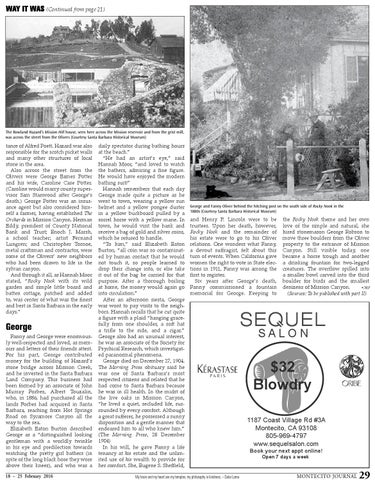WAY IT WAS (Continued from page 21)
The Rowland Hazard’s Mission Hill house, seen here across the Mission reservoir and from the grist mill, was across the street from the Olivers (Courtesy Santa Barbara Historical Museum)
tance of Alfred Poett. Hazard was also responsible for the scotch picket walls and many other structures of local stone in the area. Also across the street from the Olivers were George Eames Potter and his wife, Caroline Case Potter. (Caroline would marry county supervisor Sam Stanwood after George’s death.) George Potter was an insurance agent but also considered himself a farmer, having established The Orchards in Mission Canyon. Herman Eddy, president of County National Bank and Trust; Enoch J. Marsh, a school teacher; artist Fernand Lungren; and Christopher Tornoe, metal craftsman and contractor, were some of the Olivers’ new neighbors who had been drawn to life in the sylvan canyon. And through it all, as Hannah Moor stated, “Rocky Nook with its wild garden and simple little board and batten cottage, patched and added to, was center of what was the finest and best in Santa Barbara in the early days.”
George
Fanny and George were enormously well-respected and loved, as memoirs and letters of their friends attest. For his part, George contributed money for the building of Hazard’s stone bridge across Mission Creek, and he invested in the Santa Barbara Land Company. This business had been formed by an associate of John Murray Forbes, Albert Touzalin, who, in 1886, had purchased all the lands Forbes had acquired in Santa Barbara, reaching from Hot Springs Road on Sycamore Canyon all the way to the sea. Elizabeth Eaton Burton described George as a “distinguished looking gentleman with a worldly twinkle in his eye and predilection towards watching the pretty girl bathers (in spite of the long black hose they wore above their knees), and who was a 18 – 25 February 2016
daily spectator during bathing hours at the beach.” “He had an artist’s eye,” said Hannah Moor, “and loved to watch the bathers, admiring a fine figure. He would have enjoyed the modern bathing suit!” Hannah remembers that each day George made quite a picture as he went to town, wearing a yellow sun helmet and a yellow pongee duster in a yellow buckboard pulled by a sorrel horse with a yellow mane. In town, he would visit the bank and receive a bag of gold and silver coins, which he refused to handle. “To him,” said Elizabeth Eaton Burton, “all coin was so contaminated by human contact that he would not touch it, so people learned to drop their change into, or else take it out of the bag he carried for that purpose. After a thorough boiling at home, the money would again go into circulation.” After an afternoon siesta, George was wont to pay visits to the neighbors. Hannah recalls that he cut quite a figure with a plaid “hanging gracefully from one shoulder, a soft hat a trifle to the side, and a cigar.” George also had an unusual interest, he was an associate of the Society for Psychical Research, which investigated paranormal phenomena. George died on December 27, 1904. The Morning Press obituary said he was one of Santa Barbara’s most respected citizens and related that he had come to Santa Barbara because he was in ill health. In the midst of the live oaks in Mission Canyon, “he lived a quiet, secluded life, surrounded by every comfort. Although a great sufferer, he possessed a sunny disposition and a gentle manner that endeared him to all who knew him.” (The Morning Press, 28 December 1904) In his will, he gave Fanny a life tenancy at his estate and the unlimited use of his wealth to provide for her comfort. She, Eugene S. Sheffield,
George and Fanny Oliver behind the hitching post on the south side of Rocky Nook in the 1880s (Courtesy Santa Barbara Historical Museum)
and Henry P. Lincoln were to be trustees. Upon her death, however, Rocky Nook and the remainder of his estate were to go to his Oliver relations. One wonders what Fanny, a devout suffragist, felt about this turn of events. When California gave women the right to vote in State elections in 1911, Fanny was among the first to register. Six years after George’s death, Fanny commissioned a fountain memorial for George. Keeping to
My brain and my heart are my temples; my philosophy is kindness. – Dalai Lama
the Rocky Nook theme and her own love of the simple and natural, she hired stonemason George Robson to move three boulders from the Oliver property to the entrance of Mission Canyon. Still visible today, one became a horse trough and another a drinking fountain for two-legged creatures. The overflow spilled into a smaller bowl carved into the third boulder for birds and the smallest denizens of Mission Canyon. •MJ (Sources: To be published with part II)
SALON
$32 Blowdry 1187 Coast Village Rd #3A Montecito, CA 93108 805-969-4797 www.sequelsalon.com Book your next appt online! Open 7 days a week
MONTECITO JOURNAL
29
